



I have many sets of instruments that have no indication of who made them on either the instruments or the case. In this section I have placed illustrations of some of them in the hope that someone might be able to identify the makers for me. I think it likely that all of these instruments are of foreign (i.e. not British) manufacture. Traditional pattern British instruments were expensive and in the late 1800s and early 1900s there was a ready market amongst students for cheaper alternatives.
In some cases I am pretty sure of the country of origin and there may be several possible manufacturers because they all made similar instruments. In this case it would be useful to have a list of all the possibles.

Nickel-Silver Instruments
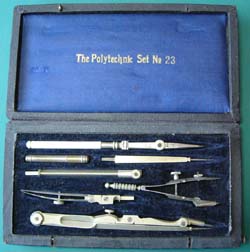
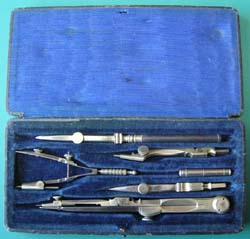
A very similar set to the Polytechnic Set but the compass has a needle point held in place in a typically Continental manner.
More Nickel-Silver Instruments
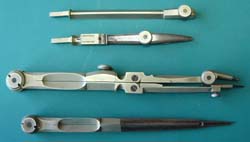 Compass and dividers.
Compass and dividers.
These instruments, of a similar pattern but somewhat heavier in construction, could be German. The compass has joints in both legs.
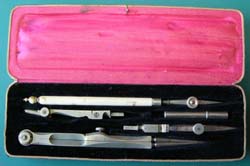
The style of points on the compass is definitely not British and the case is also of European manufacture. The pen is British and may have been a replacement.
Different Patterns
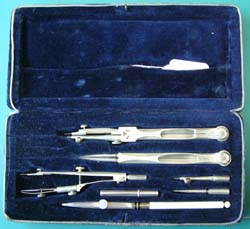
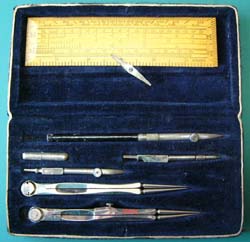
The instruments in this set are plated and quite crude. The boxwood protractor was made in England.
A Common Pattern
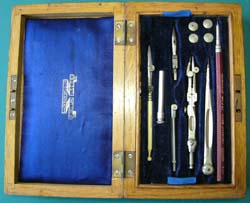
Jackson Bros of Call Lane Leeds retailed this set. The case is of oak and British made, the pencil was made for Jackson's by Staedtler. The other instruments, although stamped "Jackson" are very similar to those found in sets with several other retailers names and would, I believe, have been imported. The style of compass suggests these instruments were made in Germany.
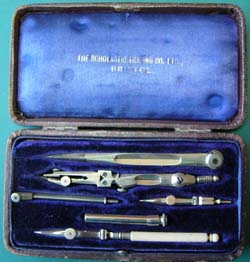
The Scholastic Company of Bristol sold this set. This is the size of case and set most usually found. The instruments are small in size.
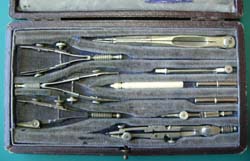
This set was presented to its original owner in 1933. The compass is the same size and pattern as in the two preceding sets. The pen is missing except for its handle. The spring bows are probably British as is the case.
A Mongrel?
This set has a mixture of British and foreign attributes. The case is probably British and the compass needle points are of the British pattern frequently called "Type B". However the form of clamping screw for the inserts is the type found on some Swiss and German instruments. The pen handle has the English style of finial but the rest is definitely continental.
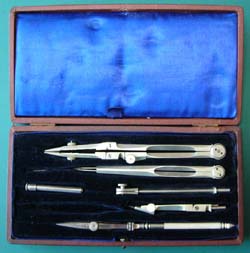
Cheap French Sets
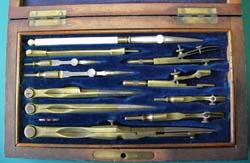
Hambly (Ref. 1) shows several pictures of French sets in which the instruments have a very characteristic form so I am pretty confident in assigning these sets to that country. The double turn locks on some of the boxes are also characteristically French.
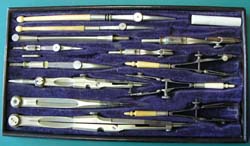
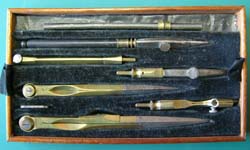
This tray of brass instruments is from a rosewood veneered case.
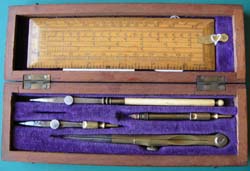
The protractor in this case is British but the remaining instruments are French.
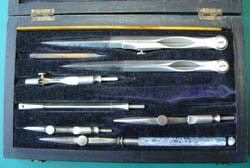
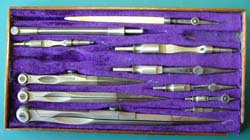
This tray of nickel-silver instruments is from a rosewood veneered box. The smallest compass is missing.
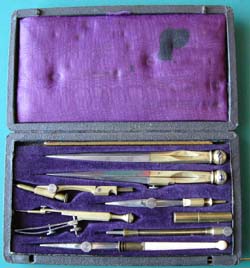
Opposite is a school set presented by the City of Manchester Education Committee in 1907 to Frank Miller, of the Miston Lane Municipal Boys School for punctual and regular attendance. These sets sold for a few shillings and were typical school sets of this period. They were imported, probably from France, and sold by many well known retailers. The cases were made of pine and velvet lined with a flap inside the lid which opened to expose the brass protractor. I have another dated 1895.
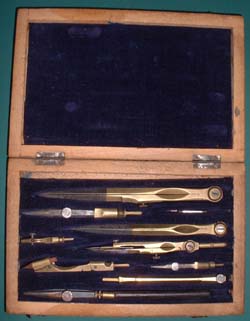
School prize set. There is a prize presentation label on the bottom of the case
"The Polytechnic Set No 23"
This was the first set that I bought and the instruments, although of cheaper construction than the traditional British pattern, are quite serviceable. The pens have opening nibs for cleaning. The spring bow is possibly British (it is of the British pattern).
An unusual pattern.
The inserts in this case fit both compasses and fit over a spigot on the compass or spring bow with a slot around the clamping screw.
This set is typical of these cheap French sets that were sold for use by students. I have three sets of this size and have seen many more. Mostly the instruments are brass (as in this case) but sometimes they are nickel-silver.
This set is made of nickel-silver and is of rather higher quality than most of these sets. The spring bows have ivory handles. I was given this tray of instruments; the rest of the box no longer exists but may have had a maker's name on the lid lining.
This set is made of nickel-silver but is very basic. It is housed in a rosewood veneered pine box and is missing the small compass.
This brass set is of superior quality to the others. The ball type heads to the compass and dividers are signs of this as is the holder for pencil leads that fits into the pencil insert.
The compass and dividers are stamped "deposé" which means "registered" and presumably refers to the design of the head.
| Early Sets |
| Traditional Sets |
| Later Sets |
| Major Makers |
| Instruments |
| Miscellanea |
| W F Stanley |
| A G Thornton |
| W H Harling |
| Elliott Bros |
| J Halden |
| Riefler |
| E O Richter |
| Kern, Aarau |
| Keuffel & Esser |
| Compasses |
| Pocket compasses |
| Beam compasses |
| Dividers |
| Proportional dividers |
| Pens |
| Pencils |
| Rules |
| Protractors |
| Squares |
| Parallels |
| Pantographs |
| Sectors |
| Planimeters |
| Map Measurers |
| Miscellaneous |
| Materials Used |
| Who made them |
| Who made these |
| Addiator |
| Addimult |
| Other German |
| USA |
| Miscellaneous |
| Microscopes |
| Barometers |
| Hydrometers & Scales |
| Pedometers |
| Other instruments |
| Workshop Measuring Tools |
| Catalogues & Brochures |